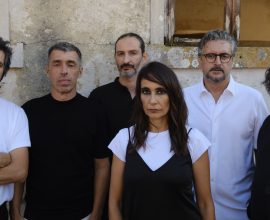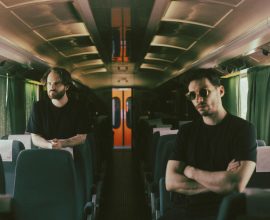Interview: “They called us witches; we became a band”, The Charmers
Between past and present, The Charmers emerges as a deeply sensory and politically conscious project, where music, visual art, and historical research intertwine to give voice to forgotten figures — namely, women and other marginalized individuals accused of witchcraft in 17th-century Scotland.
Conceived by multidisciplinary artist Anne Robinson, the EP Not To Be Found stems from extensive archival research, transformed into a musical narrative that reimagines the possible fate of a real group of people accused of witchcraft, recorded in a legal scroll from 1658. Through speculative imagination, these figures are brought back to life as a “band of time-travelling players” — turning history into sound, image, and performance. In this interview, we explore the origins of this unique project, its blend of myth and reality, and how music becomes a tool for resistance, remembrance, and transformation. The Charmers is not just a record — it is a space for listening, questioning, and belonging, especially for those who have ever felt like outsiders.
Not To Be Found is an EP with a very unique concept, based on historical research into the witch trials in Scotland. How did the idea for the project come about and how did you transform this research into music?
I am a visual artist – quite multidisciplinary, but usually working with film and sometimes collaborating with musicians. The ‘Charmers’ work developed out of an earlier with ‘The Hurrier’ (2021) which was a 5 screen installation built around a kind of experimental ballad. This work involved looking into records of my matrilineal ancestors.. mostly in old church records in south-west Scotland. These women were poor and often chastised by the authorities. I knew the ‘witch’ trials in my home town of Ayr and in surrounding area, were intense and I made the connection with women and outsiders getting into trouble but back in the 1600s, this could involve being accused of witchcraft and even executed. I also did an artist’s residency at Beaconsfield Contemporary Art in London in 2022 which developed the work, but
also increasingly found the research really quite traumatic – then I found on a legal scroll from 1658, a record of seven people (6 women, 1 man) accused as a ‘coven’ and they had apparently got away just before their trial. So, from there, I speculated how they could have escaped and lived and a ‘band of travelling players, became a band of time-travelling players – and eventually a real band!
The concept behind The Charmers blends history, mythology, and social commentary. How did you incorporate these themes into the music and visuals of the project?
I wrote the songs (including the ones on EP) in the project over the course of about 2 years – and got help and advice from the musicians involved along the way. The lyric writing process is kind of incorporating some basic narratives, inventing characters – and I have previously done poetic writing of this kind as part of my art practice – and also important have been some phrases I came across during the research such as ‘if you say so, so I am’ – final recorded words of an accused witch in Ayr, before execution – so influenced by ‘fictioning’, speculative fiction’ and also the idea of ‘critical fabulation’ from writer Saidiya Hatrman.
The EP combines different styles, referencing folk and electronic music. What were the main musical influences behind this work?
Hard to say! But possibly for me at least, Sandy Denny, Patti Smith and Scottish folk ballads
The cover artwork is quite striking. How does Anne Robinson’s work as a visual artist complement the music and overall concept of the project?
Basically I guess the record and the songs are part of my art practice – so use the kind of experimental film style from my earlier work. During gigs, we have projections specially made for each song – some incorporating forms of animation and overlays and images of witches’ familiars/animals – but also the invented queer characters portrayed by performers that I filmed
The EP includes tracks like “Song for the Leaving”. What stories or emotions do your songs aim to convey?
They are different from each other really – so some more expressing rage injustices of this time in history, but also thinking of the real people involved, connecting ideas to now, and also wanting to offer hope and resistance – so not all just based around horror. I think ‘Sing for the Leaving’ sounds very sad, but also welcomes all the outsiders in I hope in a comforting way – so.. rage, sorrow, hope and comfort!
The Charmers is a multidisciplinary project, including films, workshops, and conversations. How does the music integrate with these other art forms, and what kind of complete experience do you hope to offer the audience?
I think I have partly answered this above – but also I hope that the audience experience involves responding to the way the songs make these named from old documents into real people and also allows for magical speculation through the words and pictures.
The concept of ‘fugitive witches’ forming a band in a parallel universe seems to resonate in the songs and lyrics of the EP. How does this narrative reflect in the sound of the tracks?
Yes this theme is very important as in fact the work developed from the research and discoveries and then imaginative story-building process – there is some call and response in the vocals as performed live, the fiddle evokes the Scottish setting and guitar sounds are at times pretty harsh and effective in conveying some of the fear and intensity I think.
The release coincides with the live show in Edinburgh. What can fans expect from this live performance at the Fruitmarket?
We have done some gigs already which have been very well received with a lot of audience members both enjoying the music – it is quite an unusual hybrid sound, and also very engaged with the ideas and histories – and expect this to be similar at Fruitmarket – this venue is actually very close to where accused witches were imprisoned, tried and executed in Edinburgh.
How do you prepare to perform The Charmers live, given that it’s such a visual and immersive project? How does the energy on stage differ from the recorded version of the EP?
It is immersive, and although to a great extent, the practicalities of putting on alive gig take over, we have been very aware of what the words are about and also of great connection with the audiences.
With a live lineup made up of musicians from different backgrounds and styles, what is the dynamic like during rehearsals and performances?
It has been interesting to recognise how practice can differ for classical, folk, rock etc – but we have really developed over past year or so, and se enjoyed working together – perhaps the differences contribute to the unusual sound!
The project has a strong connection to themes of resistance, rebellion, and questioning authority. How are these themes explored live, especially in a venue like the Fruitmarket?
I think I answered this a bit already, but really within the song lyrics, in the appearance of the performers I worked with (who we see in the films) and also in the ballads where there is a sense of defiance and hope in the instrumentation and arrangements for these pieces.
The relationship between the witch trials and contemporary social issues like misogyny and marginalization seems to be a central theme in the project. Whatmessages do you hope the audience will take away from listening to the EP and seeing the live performance?
Yes, this is definitely important to me as an artist and writing the songs – and we have had discussions with people in audiences – and also places where I had done artist talks about this work – sometimes relating the control of church and state Scotland in the 16 th /17 th centuries which was extremely misogynistic to contemporary societies where this is the case – and also both queer experience and attitudes to migrants in contemporary times.
The concept of the fugitive witches seems to evoke a sense of freedom and transformation. How does the idea of ‘escape’ and resistance translate into the band’s sound and Anne Robinson’s visual art?
Again, see above – and also, this has been important in earlier works like ‘the hurrier’ which are often exploring tiny fragments from records of real people whose lives were not seen as important.
Anne, how was the historical research process that inspired the project, and how did the discoveries along the way shape the creative directions for both the artistic and musical elements of The Charmers?
I said a bit about this for question 1 – and the moment of thinking maybe a ‘band’ would be a great way of expressing these ideas and building a storyline was really important – before that, lots of local and archives – especially the ‘Kirk Sessions’ which were a sort of church court in Scotland actively chastising women until about 1920!
How does The Charmers address issues of identity and ‘otherness’ in a musical and artistic context?
These issues are central to the project – it was so obvious through research that most people tried and executed were being punished for not conforming to social roles – around sexuality, gender conformity, obedience to authority, and so on. Most but not all were women – about 85% This was of course a huge trauma which had repercussions for centuries afterwards – and I was conscious of the echoes in the present day – and there is a kind of story running though the work where a young queer person in the present is listening to voices form the past. Queer lives were largely undocumented before the later 20 th century – but I have speculated that this coven of seven were ‘othered’ people who find solace in other times.
After the EP release and live performance, what are the next steps for The Charmers? Are there plans to expand the concept into other formats, like more films or a full-length album?
It is likely in the shorter term that the work will develop in film form – and shown in gallery spaces with performance – and there are other songs now, so hopefully releasing those as well – watch this space!
The project seems to have a strong connection to themes of transformation and resistance. What are your expectations for how the audience, especially at live shows, will connect with the message of The Charmers?
Again – see above – and I very much hope they do pick up on these central themes of the project. Thank you for your very thoughtful questions, really engaging with the sounds and images!





